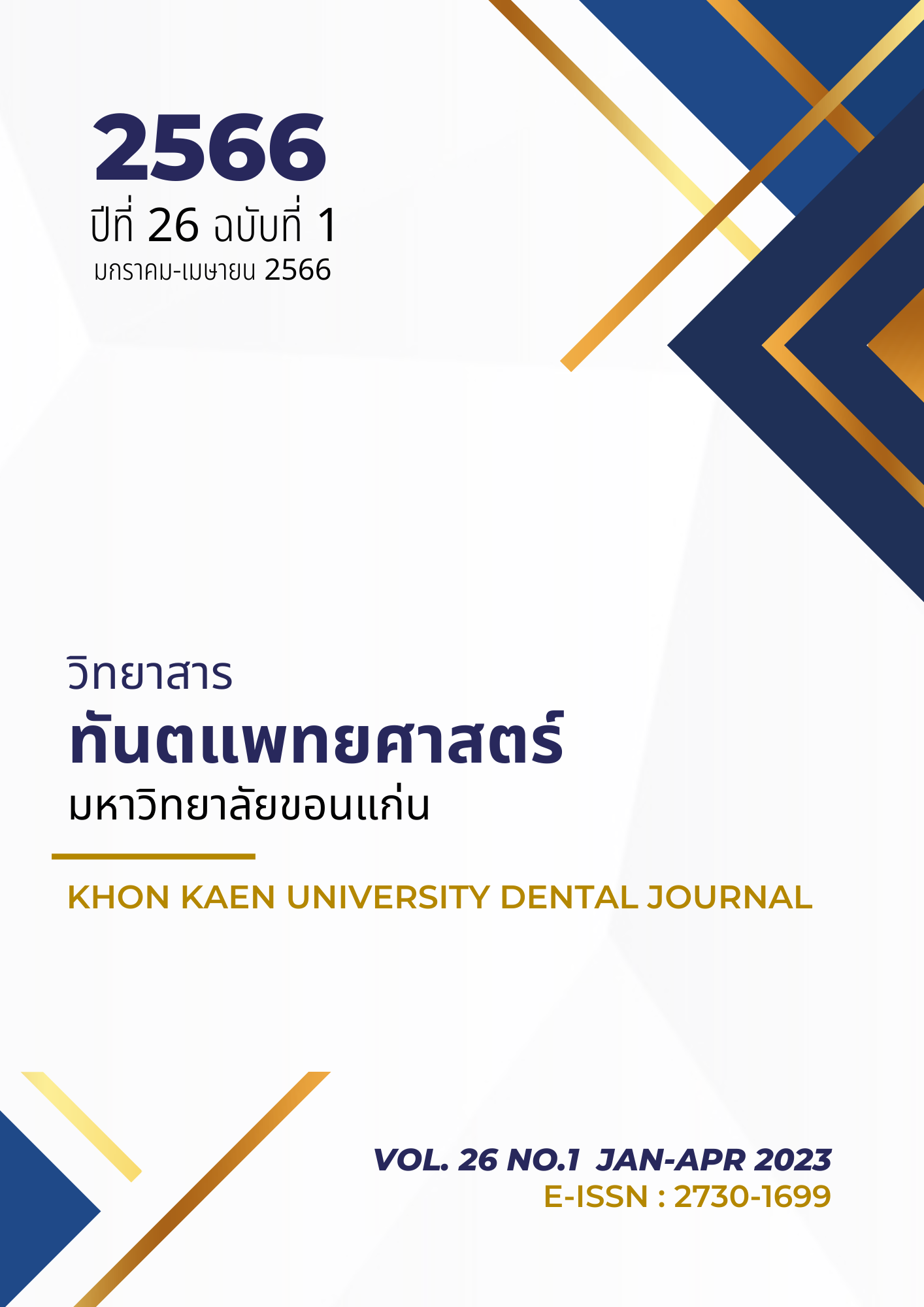Effect of Etching Time on Microtensile Bond Strength to Amalgam-Discolored Dentin
Main Article Content
Abstract
The aim of this study was to examine the effect of etching time on microtensile bond strength (µTBS) to amalgam-discolored dentin. Twenty extracted restoration-free human molars (normal dentin group) and twenty extracted amalgam-filled human molars (discolored dentin group) were prepared. After removal of amalgam in discolored dentin group, the teeth in both groups were cut horizontally to expose flat mid-dentin surfaces. Each specimen was sectioned into 2 subgroups according to 37% phosphoric acid etching time of 15 and 60 s. Subsequently, the specimens were bonded with 3-step etch and rinse adhesive (OptiBond™ FL, Kerr, CA, USA) and restored with resin composite. The bonded specimens were subjected to microtensile bond strength (µTBS) test. Data were statistically analyzed by two-way ANOVA and Tukey’s test at significance level of 95%. The fractured surfaces of all specimens were examined using stereomicroscope. The results exhibited that µTBS of 15-s etching time on amalgam-discolored dentin group was significantly lower than normal dentin group. Increasing etching time to 60 s on amalgam-discolored dentin could significantly increase µTBS (p<0.05). From the result of this study, prolonged etching time to 60 s could improve µTBS of amalgam-discolored dentin with etch-and-rinse dental adhesive system.
Article Details

This work is licensed under a Creative Commons Attribution-NonCommercial-NoDerivatives 4.0 International License.
บทความ ข้อมูล เนื้อหา รูปภาพ ฯลฯ ที่ได้รับการลงตีพิมพ์ในวิทยาสารทันตแพทยศาสตร์ มหาวิทยาลัยขอนแก่นถือเป็นลิขสิทธิ์เฉพาะของคณะทันตแพทยศาสตร์ มหาวิทยาลัยขอนแก่น หากบุคคลหรือหน่วยงานใดต้องการนำทั้งหมดหรือส่วนหนึ่งส่วนใดไปเผยแพร่ต่อหรือเพื่อกระทำการใด ๆ จะต้องได้รับอนุญาตเป็นลายลักษณ์อักษร จากคณะทันตแพทยศาสตร์ มหาวิทยาลัยขอนแก่นก่อนเท่านั้น
References
Ritter AV. Sturdevant’s Art & Science of Operative Dentistry. 7th ed. St. Louis: Elsevier, 2017:306-10.
Moraschini V, Fai CK, Alto RM, Dos Santos GO. Amalgam and resin composite longevity of posterior restorations: A systematic review and meta-analysis. J Dent 2015;43(9):1043-50.
Mjor I, Gordan V. Failure, repair, refurbishing and longevity of restorations. Oper Dent 2002;27(5):528-34.
Massler M, Barber TK. Action of amalgam on dentin. J Am Dent Assoc 1953;47(4):415-22.
Kurosaki N, Fusayama T. Penetration of elements from amalgam into dentin. J Dent Res 1973;52(2): 309-17.
Harnirattisai C, Senawongse P, Tagami J. Microtensile bond strengths of two adhesive resins to discolored dentin after amalgam removal. J Dent Res 2007; 86(3):232-6.
Sato Y, Fusayama T. Removal of dentin by fuchsin staining. J Dent Res 1976;55(4):678-83.
Kuboki Y, Liu CF, Fusayama T. Mechanism of differential staining in carious dentin. J Dent Res 1983;62(6):713-4.
Fusayama T,Terashima S. Differentiation of the two layers of carious dentin by staining. J Dent Res 1972;51(3):866.
Wei SH, Ingram M. Analyses of the amalgam-tooth interface using the electron microprobe. J Dent Res 1969;48(2):317-20.
Mateer RS, Reitz CD. Galvanic degradation of amalgam restorations. J Dent Res 1972;51(6): 1546-51.
Holland GA, Asgar K. Some effects on the phases of amalgam induced by corrosion. J Dent Res 1974;53(5):1245-54.
Halse A. Metals in dentinal tubules beneath amalgam fillings in human teeth. Arch Oral Biol 1975;20(1):87-8.
Sarkar N, Fuys R, Schoenfeld C, Armstrong L, Stanford J. The tooth‐amalgam interaction. J Oral Rehabil 1981;8(5):401-11.
Grossman E, Witcomb M, Jodaikin A. Elements in marginal seals at amalgam-tooth interfaces. J Dent Res 1986;65(7):998-1000.
Scholtanus JD, Özcan M, Huysmans M-CD. Penetration of amalgam constituents into dentine. J Dent 2009;37(5):366-73.
Scholtanus JD, van der Hoorn W, Ozcan M, Huysmans M, Roeters J, Kleverlaan CJ, et al. Staining of dentin from amalgam corrosion is induced by demineralization. Am J Dent 2013; 26(4):185-90.
Ellender G, Ham KN, Harcourt JK. The ultrastructural localization of the corrosion products of dental amalgam. Aust Dent J 1979; 24(3):174-7.
Arrais CA, Giannini M, Nakajima M, Tagami J. Effects of additional and extended acid etching on bonding to caries-affected dentine. Eur J Oral Sci 2004;112(5):458-64.
Lopes GC, Vieira LC, Monteiro S, Jr., Caldeira de Andrada MA, Baratieri CM. Dentin bonding: effect of degree of mineralization and acid etching time. Oper Dent 2003;28(4):429-39.
Karan K, Yao X, Xu C, Wang Y. Chemical characterization of etched dentin in non-carious cervical lesions. J Adhes Dent 2012;14(4):315-22.
Lopes GC, Baratieri CM, Baratieri LN, Monteiro S, Jr., Cardoso Vieira LC. Bonding to cervical sclerotic dentin: effect of acid etching time. J Adhes Dent 2004;6(1):19-23.
Al-Sugair MH, Akpata ES. Effect of fluorosis on etching of human enamel. J Oral Rehabil 1999; 26(6):521-8.
Ateyah N, Akpata E. Factors affecting shear bond strength of composite resin to fluorosed human enamel. Oper Dent 2000;25(3):216-22.
Torres-Gallegos I, Zavala-Alonso V, Patino-Marin N, Martinez-Castanon GA, Anusavice K, Loyola-Rodriguez JP. Enamel roughness and depth profile after phosphoric acid etching of healthy and fluorotic enamel. Aust Dent J 2012;57(2):151-6.
Perdigão JL, Manuela. The effect of etching time on dentin demineralization. Quintessence Int 2001;32(1):19-26.
Wang Y, Spencer P. Effect of acid etching time and technique on interfacial characteristics of the adhesive-dentin bond using differential staining. Eur J Oral Sci 2004;112(3):293-9.
Marshall GW, Jr., Inai N, Wu-Magidi IC, Balooch M, Kinney JH, Tagami J. Dentin demineralization: effects of dentin depth, pH and different acids. Dent Mater 1997;13(6):338-43.
Hashimoto M, Ohno H, Kaga M, Sano H, Tay FR, Oguchi H, et al. Over-etching effects on micro-tensile bond strength and failure patterns for two dentin bonding systems. J Dent 2002;30(2-3):99-105.
Pashley DH, Tay FR, Yiu C, Hashimoto M, Breschi L, Carvalho RM, et al. Collagen degradation by host-derived enzymes during aging. J Dent Res 2004;83(3):216-21.
Tjaderhane L, Buzalaf MA, Carrilho M, Chaussain C. Matrix metalloproteinases and other matrix proteinases in relation to cariology: the era of 'dentin degradomics'. Caries Res 2015;49(3):193-208.


